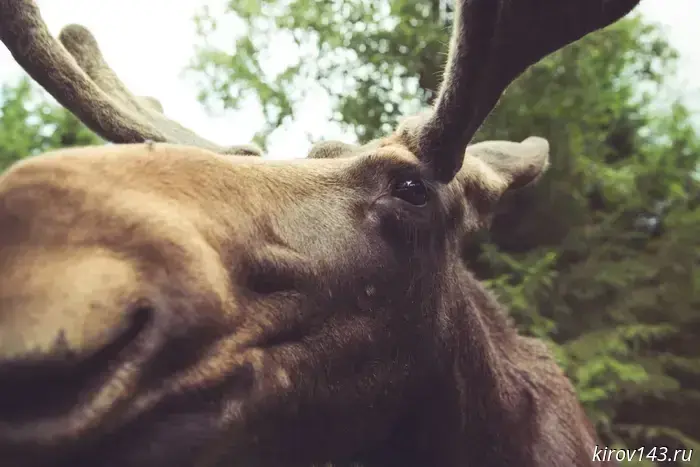
April in the forest: the bear comes out of the den, the moose grows horns
In April, the bear's exit from the den begins. Clubfoots wake up very thin and need increased nutrition. The bear's spring food consists of insects and underground parts of plants. In addition, a bear can eat carrion, as well as attack a moose.
Male moose continue to grow horns in April. Moose habitats are aspen forests, valleys of forest rivers and the outskirts of swamps. In April, wild boars have a litter of up to 10 piglets. Female wild boar in the thicket of the forest arrange a kind of nest of grass and brushwood. Piglets walk in herds, and cleavers walk alone in remote places.
Wolves have a spring molt. There are from 3 to 8 cubs. In April, these animals are hardly noticeable and it is very difficult to find a wolf's lair. It is located in a badger or fox hole expanded by wolves, some natural depression, and sometimes openly, among thickets and thickets. There must be water near the lair.
Lynxes are running out of rut at this time. Young lynxes join their mother and start walking and hunting with her. When there is an abundance of food, the lynx lives sedentary, when there is a shortage, it roams up to 30 km per day. The lynx's diet is based on hares. Lynx also hunts grouse birds, small rodents, foxes, raccoon dogs and other small animals.
Foxes begin to breed in April: the number of puppies in a litter is from 4 to 10. Pups occur in burrows, hollows of fallen trees and various shelters. Lisovin feeds the female for the first time, and then the children.
The raccoon dog comes out of its burrows in April, and its mating season begins. The marten's feeding conditions are dramatically improving due to the start of mass nesting of birds. In April, the squirrels may have a late offspring. The number of cubs in it depends on the feeding conditions. By the end of April, the squirrels of the first brood become independent. The second rutting period begins, and molting continues.
Ferrets and minks are running out of mating time. The ermine completes its false rut, and the spring molt continues. Badgers have offspring. The number of cubs in a litter is from two to six. Badgers forage in the vicinity of the burrow, feeding on frogs, earthworms, beetles, underground tubers, bulbs and rhizomes. Badgers are mostly nocturnal.
Hares in the northern regions have their first litter, molt rapidly, and their hair falls out in clumps.
Beaver dwellings are flooded with water, and beavers either swim or rest and sleep in some temporary shelter. After the water subsides, they return to their homes and repair them.
Другие Новости Кирова (НЗК)
 The "pioneer tie" was lit at the former Palace of Pioneers
The roof of the Memorial Palace of Creativity in Kirov began to glow red.
The "pioneer tie" was lit at the former Palace of Pioneers
The roof of the Memorial Palace of Creativity in Kirov began to glow red.
 Approaches to memorial areas are being repaired in Kirov
Work is currently underway on the section from Pavel Krchagin Street to the monument to fallen soldiers.
Approaches to memorial areas are being repaired in Kirov
Work is currently underway on the section from Pavel Krchagin Street to the monument to fallen soldiers.
 Love horoscope: Cancers will start to rebel, and Scorpios will experience a sense of relief
Astrologers told us what events will take place in the personal life of each zodiac sign this Saturday.
Love horoscope: Cancers will start to rebel, and Scorpios will experience a sense of relief
Astrologers told us what events will take place in the personal life of each zodiac sign this Saturday.
 Renovation of the Eternal Flame on the Green Embankment continues in Kirov
Workers are putting the memorial area on the Green Embankment in order.
Renovation of the Eternal Flame on the Green Embankment continues in Kirov
Workers are putting the memorial area on the Green Embankment in order.
 Kirov resident was punished for supporting terrorists on social networks
The Central District Military Court found a resident of the Kirov region guilty of publicly justifying terrorism. The reason was the statements on the social network regarding the actions of the Ukrainian special services.
Kirov resident was punished for supporting terrorists on social networks
The Central District Military Court found a resident of the Kirov region guilty of publicly justifying terrorism. The reason was the statements on the social network regarding the actions of the Ukrainian special services.
 Pensions in Russia will be indexed twice a year
Speaker of the Legislative Assembly of the Kirov region Roman Beresnev said that, according to the approved Strategy, insurance pensions will be indexed twice a year.
Pensions in Russia will be indexed twice a year
Speaker of the Legislative Assembly of the Kirov region Roman Beresnev said that, according to the approved Strategy, insurance pensions will be indexed twice a year.
April in the forest: the bear comes out of the den, the moose grows horns
The Ministry of Environmental Protection of the Kirov region told how wild animals live with the onset of April.
